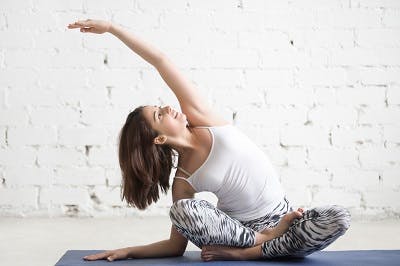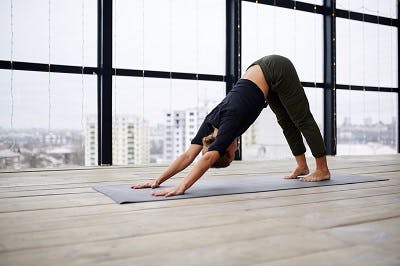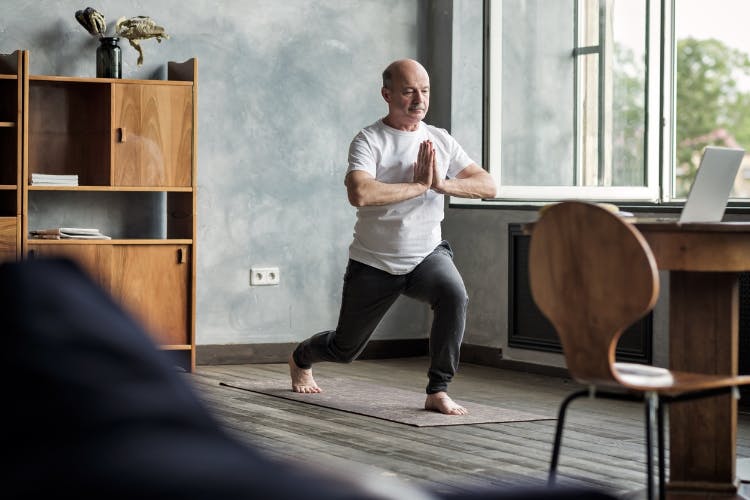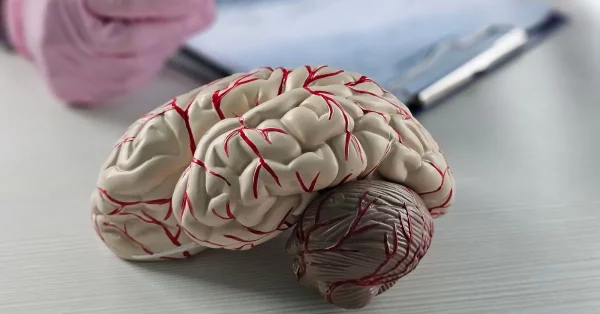Certain yoga poses for brain injury patients offer a gentle, therapeutic alternative to traditional exercises. Even if you have limited movement or balance, you can still take part in yoga by adapting it to fit your needs.
Today’s article will show you a few yoga poses to help you regain balance skills after brain injury and relearn proper movement sequencing.
Benefits of Yoga for Brain Injury
Yoga is a therapeutic activity that engages both the mind and body, making it ideal for individuals after a traumatic brain injury (TBI).
The breathing techniques teach people to quiet their minds and focus on their movements, which relieves stress and anxiety. This allows the brain to heal itself more efficiently.
That’s not the only benefit that yoga offers patients after a TBI. One study conducted by Purdue University found that patients using modified yoga increased their balance by 36% and their lower-extremity strength by 100%.
Many of the patients were able to complete movements while in a wheelchair, which goes to show that anyone can benefit from yoga.
Beginner Yoga Poses for Brain Injury Patients in Wheelchairs
These yoga poses have been adapted to help patients in wheelchairs enjoy the benefits of yoga.
Eagle Pose

This yoga pose for brain injury patients stretches your shoulders and back.
- First, begin by inhaling and raising your hands up to your eyes.
- Next, cross your arms at your elbows so that your hands are intertwined, as in the photo above. Exhale slowly as you do this.
- While your arms are crossed, lift them up above your head.
Finally, hold your arms in that position for 20-30 seconds. Make sure you focus on your breathing.
Side Stretch

This pose will stretch your obliques.
- To begin, lift your right arm up and over your head as you inhale.
- Next, exhale slowly and lean your torso as far to the left you can go. Keep stretching your arm over your head.
- Hold pose for three to five breaths.
Slowly inhale and bring your torso back to the center. Repeat on other arm.
Leg Stretch
This is a great pose to use to stretch your hamstring muscles.
- Start by inhaling slowly while lengthening your spine and sitting up as straight as possible.
- Then, breathe out and reach your hands down around the back of your knee.
- Next, lift your knee straight up as a high as you can without pain.
Hold the stretch for three to five breaths, then release and switch to the other side.
Modified Cat-Cow Pose
This pose will help stretch your neck and back.
- Begin by placing your hands on your thighs or gripping the sides of your chair, whichever is easier.
- Now exhale and round your upper body forward and drop your chin to your chest.
- Next, inhale and arch your back out and hold your chin up high.
- Finally, hold the position for several deep breaths, then relax.
Cactus Pose
This pose is a little more complicated, but will improve coordination.
- First, take five deep, slow breaths.
- Next, bring your shoulder back, and lift both your hands up to the level of your eyes. Keep both hands spread far apart. They should be about six inches away from the side of your face.
- Now, exhale and cross your right hand over to your left shoulder.
- Bring it back, and then cross your left hand to right shoulder. Remember to keep focused on your breaths.
- Repeat the motion, but this time turn your head the opposite direction that your hand is going. If you are reaching to touch your left shoulder, turn your head to the right.
- Finally, cross your left hand to your right leg, and vice versa.
For a good demonstration of these poses, plus a few bonus poses, check out the video above!
More Advanced Yoga Poses for Brain Injury Patients
These yoga poses are ideal for patients who can stand unsupported, but still struggle with balance problems after a brain injury.
For these exercises, you will use a folding chair or stool for safety.
Palm Tree
This pose helps improve balance while standing on toes.
- First, stand behind the chair with on hand resting on back of chair.
- Next, lift yourself up on your tiptoes and hold position.
- Finally, while standing on your toes, lift one arm straight up above your head.
Hold for ten seconds, then repeat with your other arm.
Tree Pose

This yoga pose for brain injury patients focuses on single-leg balance.
- Stand next to the chair with your right arm resting on it.
- Then, lift your left foot up and place the entire foot on the calf of your right leg. If you can’t lift it that high, you can just place the heel above the right ankle.
- Now, while standing in that position, lift your left arm as high above your head as possible. Hold for at least ten seconds.
For an extra challenge let go of the chair and try balancing unsupported.
Downward Facing Dog

This one is a lot more challenging than the rest and might be too difficult if you experience dizziness after head injury.
- Begin by facing the base of the chair.
- Next, inhale and lift arms over your head.
- Now bend forward and place hands on the chair’s seat (bend knees if needed).
- Finally, slowly walk your feet backward and lift the hips until you reach the down-dog position. Hold for 30 seconds.
Foot-to-Seat Pose
This pose gives you a chance to stretch your hip flexors and practice a stepping motion.
- First, face the side of the chair.
- Place your left hand on the back of the chair and step the right foot onto the seat of the chair.
- Next, lift your right arm over your head. Hold and repeat on the opposite side.
Yoga Exercises for Brain Injury
And that’s it! These are just a few examples of yoga poses for brain injury patients that will improve muscle coordination and balance.
For the best results, try to work with a yoga instructor who can help you fine-tune the exercises to fit your needs.
Just like every other form of exercise, you will need to practice these poses regularly before you’ll see results. So even if they are difficult at first, don’t give up. Eventually your brain will adjust and things will become second-nature.
We hope you enjoyed this brief glimpse into the many different adaptive yoga poses out there.










